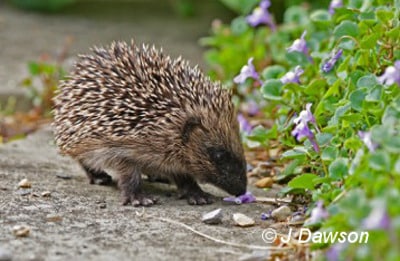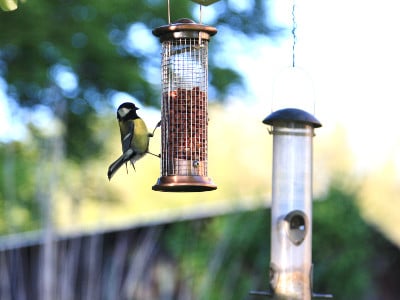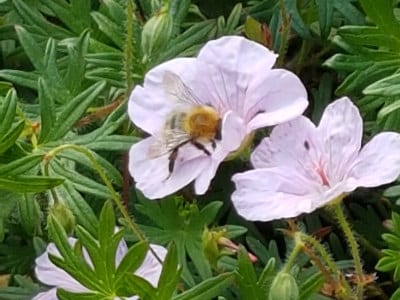In Maurice Sendak’s iconic children’s book, a young boy called Max is punished for being too wild, with an early night and no supper. That night a forest begins to grow in Max’s room and an ocean rushes by with a boat to take him to a mysterious island where the real wild things are.
Adults and kids alike often share some of the same frustrations; life is too tame, too grey and sterile and we have to behave ourselves. It’s why many of us are instinctively drawn to shoving our hands in the dirt, dealing cheerfully with smelly stuff and wonderful piles of leaves and helping colourful things to grow. Gardening is an escape from the ordinary. It’s a chance to end the day muddy, sleepy and a bit sunkissed, with dirt underneath our fingernails.

It might be us that creates these much-loved outdoor spaces – whether it’s a colourful terrace or a large garden – but they are not ours alone. Whenever we step outside, we have company; whether it’s insects buzzing around the borders or a cheeky robin waiting for you to turn over a patch of earth to bring a juicy worm or two to the surface.
Gardens are not just vital places of relaxation and recreation to us, they are greenspaces that provide, especially in our towns and cities, a wildlife habitat that would otherwise be a tiny fraction of what it is now.
Although there have been gains in some areas due to intense intervention – notably, for example, the red kite population has risen by more than 1000% between 1995 and 2014 – British wildlife is generally still in trouble.
In the State of Nature report published in 2016, the population of nearly 4,000 UK terrestrial and freshwater species was reviewed, over the 43 years from 1970. A massive 40% showed strong or moderate declines, 31% showed little change and 29% showed strong or moderate increases. The same pattern is found in more recent years, from 2002 onwards, with many more species declining in numbers than increasing.
Inviting wildlife into our gardens, whether we are city, suburb or country dwellers, is essential if our native species are not to be pushed further into cut-off pockets of wildness that shrink even more as civilisation encroaches.
Put simply, connecting with nature is good for us. There are plenty of academic studies that confirm what those of us who spend a lot of time interacting with nature already suspect – that spending time outdoors helps us avoid or bounce back from illness, boosts our mental wellbeing and improves our concentration and educational attainment.
On a bigger scale, the greener the garden, the more it offsets air and noise pollution. Planted (rather than hard landscaped gardens) also reduce flood risks and can help keep the temperatures down during heatwaves – both these issues are likely to be seen more as a result of climate change.
There are lots of resources online to help get it right. Wild About Gardens was set up by the Royal Horticultural Society and The Wildlife Trusts to encourage us to turn the estimated 24 million gardens in the UK, into a network of refuges where our once common garden visitors can start to make a comeback.
About half of UK households already feed wild birds in their garden. Feathered visitors also need fresh water for drinking and bathing. Bird baths are ideal but you need to keep them clean to prevent the spread of disease. There are bird-friendly disinfectants available but if you choose to use normal pet friendly disinfectants, make sure you rinse it thoroughly and dry before adding fresh water.
Winter feeding benefits birds the most but they can run low on food at any time of the year and feeding all year round is the best way to help them survive shortages and keep a regular flock of visitors to your garden. Good hygiene is really important, or you may do them more harm than good; always only put out the amount of food they are eating, so waste will not build up around the feeders.

Most gardeners are fond of hedgehogs. What’s not to love – they are cute, harmless and munch on slugs and snails? Sadly, this frequent garden visitor is another native species that is declining in numbers.
Like birds, hedgehogs need access to clean water that’s changed frequently. Milk and bread are not good for them but a bowl of meaty dog or cat food will be a much-appreciated supper on an evening. Fences pose problems for hedgehogs because they need connected neighbourhoods of gardens that are rich in insects and free from danger. In spite of being small and quite slow, hedgehogs travel about a mile every night and the most important thing you can do is make sure they can pass freely through your garden by making holes in or under your fence or wall. Once you have created your part of the local ‘hedgehog highway’, you can include other features such as log piles, compost heaps or an overgrown corner as suitable hedgehog habitat.
Remember if you get the strimmer out or are planning to burn garden rubbish, check there are no napping hedgehogs first.
The UK has 17 breeding species of bat who are also handy visitors to have around the garden as they feed on pesky gnats and midges on an evening when the biting ones are at their most annoying. Artificial light confuses these fascinating creatures and we can help them by minimising light pollution in our gardens and dimming or capping our security lights.
It is no secret that many of our pollinators such as bees are under threat. When you consider every third mouthful of food we eat can be attributed to the work of bees you can understand why it’s so important to do what we can to help.
Planting nectar and pollen rich flowers is your first ‘Bee Welcome’ sign. Like all of your other garden visitors, bees also need access to water and a small wildlife pond can be an attractive asset to your garden that will be used by many other visitors. Areas of long and short grass provide nesting sites for different kinds of bee and you can always provide a bit of welcome TLC if you find an exhausted bee resting on the ground.

While some people see them as pests, frogs, along with toads and newts, are actually a great asset in the garden as they are a safe and green method of slug control. You don’t need a pond to encourage frogs into your garden, they just like somewhere damp and sheltered. You might find they have already taken a shine to your compost heap or log pile so when working around it, take care as they are quite fragile creatures and also be aware they may be about when digging with a fork or spade.
Of course, not all wildlife is welcomed with open arms by every gardener. Many of us were entertained this year by Peter Rabbit, but the struggle of trying to keep bunnies at bay is very real for many people in areas with a large rabbit population. Keeping them out is the first line of defence but there are plants that are more rabbit resistant than others and a good tip is looking over the fence to see what best survives the rabbits in your neighbours’ garden to give you some planting tips.
Moles are another unpopular visitor, who you will rarely see in person. They give themselves away by the molehills they create. Deterring them can feel like a full-time occupation as when you find something that works and sends one of the little gentlemen in black velvet packing, another of his kind will invariably move in.
While there is an absence of hard scientific evidence that pets such as cats are responsible for the decline in garden birds, there is no doubt that cats (and sometimes dogs) do kill visiting birds, especially fledglings.
Here are five things you can try to reduce your (or a visiting) cat’s chance of being a successful predator, especially if you feed garden birds.
A wildlife friendly garden doesn’t have to resemble a full-on nature reserve with waist-high nettles and dense undergrowth. While some people choose to create stunning wildflower meadows and authentic habitats, we can all tweak what we most like to spend our time in, to make it more attractive to species of birds, beasties and creepy crawlies.
If you’d like to keep up to date with Rolawn advice, news and special offers by email, please sign up to our Newsletter or follow us on Facebook and Twitter.
Guest Author: Melanie Hannam
With an Honours Degree in Psychology from Durham University, and a qualification in journalism through the NCTJ, Mel draws on her knowledge of and experience in Journalism and Communications as well as her love of literature, travel and adventure to write on a range of subjects. Mel is an award-winning writer who specializes in health sector communications, but her primary passion is sled dogs and she often writes for canine-related publications and blogs.